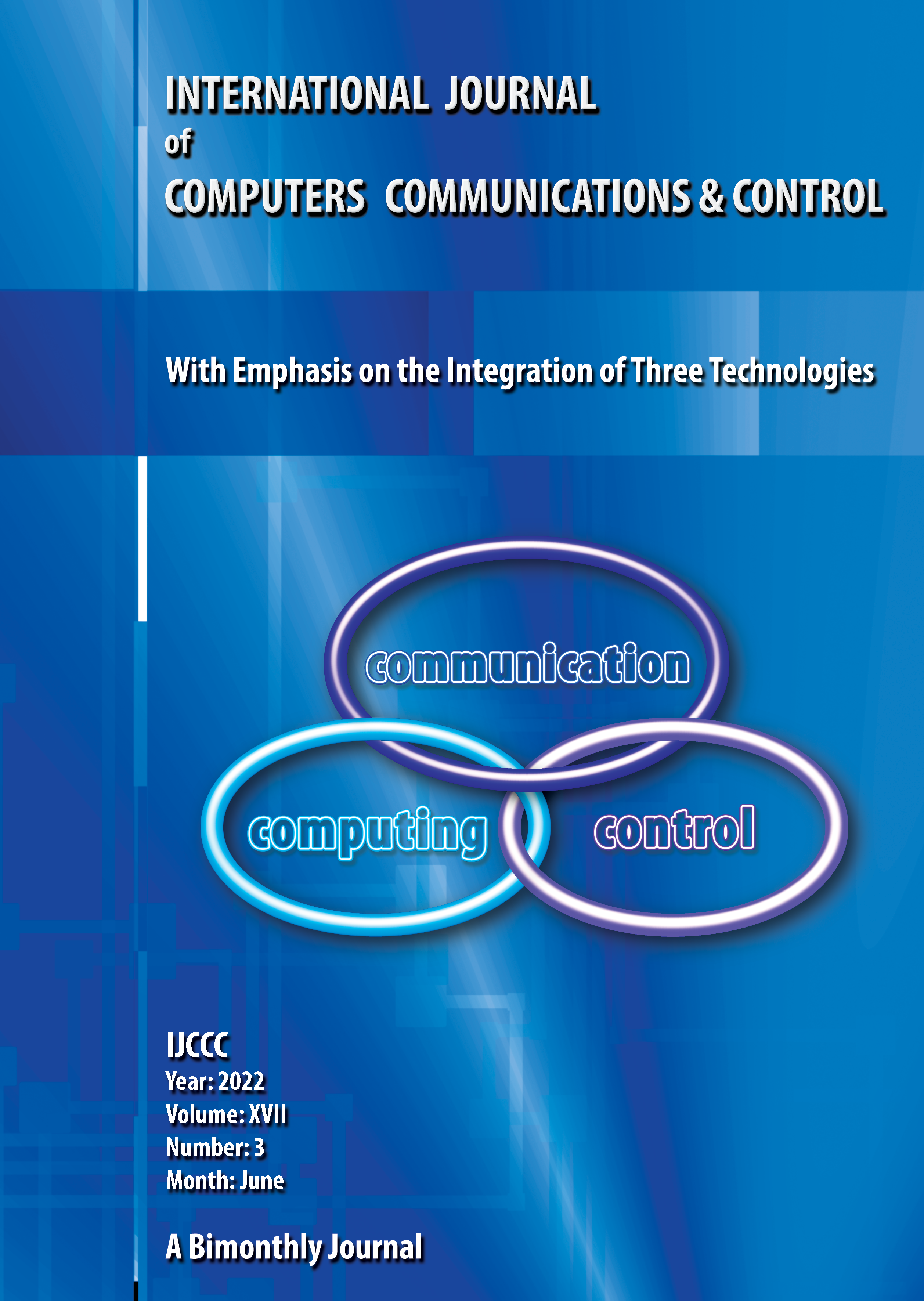Covid-19 Patients' Hospital Occupancy Prediction During the Recent Omicron Wave via some Recurrent Deep Learning Architectures
DOI:
https://doi.org/10.15837/ijccc.2022.3.4697Keywords:
prediction, COVID-19 hospital occupancy levels, Deep Learning, GRU, vaccinationAbstract
This paper described a suggested model to predict bed occupancy for Covid-19 patients by country during the rapid spread of the Omicron variant. This model can be used to make decisions on the introduction or alleviation of restrictive measures and on the prediction of oxygen and health human resource requirements. To predict Covid-19 hospital occupancy, we tested some recurrent deep learning architectures. To train the model, we referred to Covid-19 hospital occupancy data from 15 countries whose curves started their regressions during January 2022. The studied period covers the month of December 2021 and the beginning of January 2022, which represents the period of strong contagion of the omicron variant around the world. The evolution sequences of hospital occupancy, vaccination percentages and median ages of populations were used to train our model. The results are very promising which could help to better manage the current pandemic peak.
References
[2] Jason, P.; Li, W.; Lowell, L.; Moritoki, E.; Chae-Man, L.; Jigeeshu, D.; Babu, S.; Yaseen, A.; Jensen, N.; Charles G.; Masaji, N.; Younsuck, K.; Bin, D. (2020). Asian Critical Care Clinical Trials Group, Intensive care management of coronavirus disease 2019 (COVID-19): challenges and recommendations, The lancet respiratory medicine, 8(5), 506-517, 2020. https://doi.org/10.1016/S2213-2600(20)30161-2
[3] Bekker, R.; Michiel, B.; Ger, K. (2022). Modeling COVID-19 hospital admissions and occupancy in the Netherlands, European journal of operational research, In press, 2022. https://doi.org/10.1016/j.ejor.2021.12.044
[4] Le Page, M. (2021). The omicron wave, NewScientist, 252(3364), 7, 2021. https://doi.org/10.1016/S0262-4079(21)02185-0
[5] Strategists, G. (2020). COVID goes Cuckoo. How the March-April 2020 COVID-19 surge overwhelmed Dutch hospitals and undermined regular care, gupta-strategists.nl, 2020.
[6] Bouhamed, H. (2020). Covid-19 cases and recovery previsions with deep learning nested sequence prediction models with long short-term memory (LSTM) architecture, International Journal of Scientific Research in Computer Science and Engineering, 8(2), 10-15, 2020. https://doi.org/10.4018/IJBDAH.20200701.oa1
[7] Bouhamed, H. (2020). COVID-19, Bacille Calmette-Guerin (BCG) and tuberculosis: cases and recovery previsions with deep learning sequence prediction, Ingenierie des Systemes d'Information, 25(2), 165-172, 2020. https://doi.org/10.18280/isi.250203
[8] Bouhamed, H. (2020). COVID-19 Deaths Previsions With Deep Learning Sequence Prediction: Bacille Calmette-Guérin (BCG) and Tuberculosis Track, International Journal of Big Data and Analytics in Healthcare (IJBDAH), 5(2), 65-77, 2020. https://doi.org/10.4018/IJBDAH.20200701.oa1
[9] Findl, J.; Javier, S. (2021). Descriptive understanding and prediction in COVID-19 modelling, History and philosophy of the life sciences, 43(4), 1-31, 2021. https://doi.org/10.1007/s40656-021-00461-z
[10] Jaime, C.; Jí¶rgen, M.; Vatshalan, S.; Harpreet, G.; Jessica, J.; Kariem, E.; Ramai, S.; Paul, K.; Alistair, M. (2021). Predicting hospital resource use during COVID-19 surges: a simple but flexible discretely integrated condition event simulation of individual patient-hospital trajectories, Value in Health, 24(11), 1570-1577, 2021. https://doi.org/10.1016/j.jval.2021.05.023
[11] Bekker, R.; Michiel uit het, B.; Ger, K. (2022). Modeling COVID-19 hospital admissions and occupancy in the Netherlands, European journal of operational research, In press, 2022. https://doi.org/10.1016/j.ejor.2021.12.044
[12] Bouhamed, H.; Ruichek, Y. (2018). Deep feedforward neural network learning using Local Binary Patterns histograms for outdoor object categorization, Advances In Modelling And Analyses B, 61(3), 158-162, 2018. https://doi.org/10.18280/ama_b.610309
[13] Hinton, G.; Deng, L.; Yu, D.; Dahl, G. E.; Mohamed, A.; Jaitly, N.; Senior, A.; Vanhoucke, V.; Nguyen, P.; Sainath, T. N.; Kingsbury, B. (2012). Deep neural networks for acoustic modeling in speech recognition: The shared views of four research groups, IEEE Signal processing magazine, 29(6), 82-97, 2012. https://doi.org/10.1109/MSP.2012.2205597
[14] Mohamed, A.; George, E. D.; Geoffrey, H. (2011). Acoustic modeling using deep belief networks, IEEE transactions on audio, speech, and language processing, 20(1), 14-22, 2011. https://doi.org/10.1109/TASL.2011.2109382
[15] Cires, D. C.; Meier, U.; Gambardella, L. M.; Schmidhuber, J. (2010). Deep, big, simple neural nets for handwritten digit recognition, Neural computation, 22(12), 3207-3220, 2010. https://doi.org/10.1162/NECO_a_00052
[16] Yu, D.; Li, D. (2010). Deep learning and its applications to signal and information processing [exploratory dsp], IEEE Signal Processing Magazine, 28(1), 145-154, 2010. https://doi.org/10.1109/MSP.2010.939038
[17] Bengio, Y. (2009). Learning deep architectures for AI, Now Publishers Inc, 2(1), 1-56, 2009. https://doi.org/10.1561/2200000006
[18] Zikopoulos, P.; Chris, E. (2011). Understanding big data: Analytics for enterprise class hadoop and streaming data, McGraw-Hill Osborne Media, 2011.
[19] Brownlee, J. (2017). Long short-term memory networks with python: develop sequence prediction models with deep learning, Machine Learning Mastery, 2017.
[20] Hochreiter, S.; Schmidhuber, J. (1997). Long short-term memory, Neural computation, 9(8), 1735- 1780, 1997. https://doi.org/10.1162/neco.1997.9.8.1735
[21] Fernandez, A.; Bertolami, R.; Bunke, H.; Schmiduber, J. (2009). A novel connectionist system for improved unconstrained handwriting recognition, IEEE Transactions on Pattern Analysis and Machine Intelligence, 31(5), 855-868, 2009. https://doi.org/10.1109/TPAMI.2008.137
[22] Li, X.; Xihong, W. (2015). Constructing long short-term memory based deep recurrent neural networks for large vocabulary speech recognition, 2015 IEEE International Conference on Acoustics, Speech and Signal Processing (ICASSP), 4520-4524, 2015. https://doi.org/10.1109/ICASSP.2015.7178826
[23] Gers, F. A.; Schraudolph, N.; Schmidhuber, J. (2002). Learning precise timing with LSTM recurrent networks, Journal of machine learning research, 3(1), 115-143, 2002.
[24] Kyunghyun Cho, Bart van Merrienboer, Caglar Gulcehre, Dzmitry Bahdanau, Fethi Bougares, Holger Schwenk, Yoshua Bengio. (2014). Learning phrase representations using RNN encoderdecoder for statistical machine translation, arXiv preprint arXiv:1406.1078, 2014.
Additional Files
Published
Issue
Section
License
Copyright (c) 2022 Heni Bouhamed, Monia Hamdi, Rahma Gargouri

This work is licensed under a Creative Commons Attribution-NonCommercial 4.0 International License.
ONLINE OPEN ACCES: Acces to full text of each article and each issue are allowed for free in respect of Attribution-NonCommercial 4.0 International (CC BY-NC 4.0.
You are free to:
-Share: copy and redistribute the material in any medium or format;
-Adapt: remix, transform, and build upon the material.
The licensor cannot revoke these freedoms as long as you follow the license terms.
DISCLAIMER: The author(s) of each article appearing in International Journal of Computers Communications & Control is/are solely responsible for the content thereof; the publication of an article shall not constitute or be deemed to constitute any representation by the Editors or Agora University Press that the data presented therein are original, correct or sufficient to support the conclusions reached or that the experiment design or methodology is adequate.








